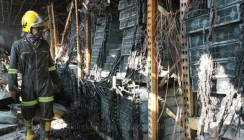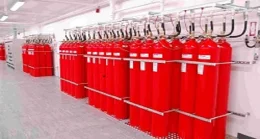How To Protect A Server Room From Fire and Smoke Damage
Your server room or data centre is one of the worst possible places for a fire to start. Business and organisation interruption are inevitable and whilst hardware can be replaced in time, very often up-to-date data cannot. Even if the fire is quickly contained, smoke from a fire can lead to extensive IT server and network peripheral damage due to the corrosive chemicals within the smoke (sulphur and chloride elements). Brief smoke exposure can damage sensitive electronics as can high temperatures and off course exposure to flames.
So just how do you protect a server room or data centre from fire and smoke damage? The best approach is to understand and remove the common causes of fire within server rooms and data centres and to install the right type of environment monitoring and fire suppression system.
The Common Causes of Server Room Fires
The CPUs (central processing units) within modern servers can draw large amounts of power and there is a cumulative effective when multiple servers are placed within a server rack cabinet.
Electrical short-circuits can occur within any component within the critical power path delivering electricity from the building incomer and LV switchboard to sub-distribution boards, UPS systems and PDUs and the server loads. Overloaded circuits are one of the most principle causes of short-circuits and fire within this type of mission critical environment and it is therefore important to ensure power supply phases are not overloaded and are balanced with adequate discrimination and fast acting circuit breaker protection.
Overheating is the second most common cause of fires and especially within high density racks when cooling systems fail. Environment and temperature monitoring can help to identify ‘hot-spots’ within server cabinets and the rooms themselves, allowing correction through better equipment layout and adequate cooling. N+X redundancy can also be built into the cooling systems with portable CRACs and air conditioning units available quickly.
Finally, the raised access floor within a server room or data centre can also hide and prevent access to faulting wiring. This is a hard issue to detect and one that can be prevented using proper channelling and correct cable installation whether its for power or data.
How to Minimise and Prevent Server Room Fires
Most server room fires are easily preventable and there are several ways to reduce the chances of a fire occurring. These include:
- Maintain suitable temperature and humidity levels: server room and data centre temperatures should be cooled to within 20-25˚C with a humidity level of 40-60% relative humidity. These factors can reduce the potential for electrostatic discharge (static electricity) and condensations and water ingress.
- Ensure proper ventilation: IT equipment within server racks must be installed to optimise cooling with the rack and prevent the build-up of ‘hot-spots’. The server racks should able be arranged into rows with easy front and rear access as well as the two end-sides. If the entire arrangement is made to optimise the floor and rack space and ensure adequate cooling, this will reduce the fire risk and make it easier to extinguish if one starts.
- Keep a clean and tidy environment: regular IT room cleaning is important to remove dust and debris and prevent this building up. Any such accumulation can lead to overheating and the potential for static as well as acting as a potential fuel for any fire. It is also important to maintain a tidy environment using structured cabling assembles and containment. Potential fuel sources including waste or shredded paper and other potential flammable items should not kept within the area.
- Regular equipment checks and maintenance: any damaged power cords or equipment must be immediately replaced. Temperature monitoring and routine maintenance can identify potential system or component failures as failing equipment tends to become less energy efficient and warmer as it nears component breakdown and end-of-life. Power supplies and batteries are good examples of this which can be caught and identified during regular preventative maintenance of critical systems (power, cooling and IT).
Above all it is important to carry out a fire risk assessment and ideally to have this completed by an external supplier or consultant who can provide an outside view and challenge assumptions
Select the Right Server Room Fire Suppression System
A fire suppression system must be installed within high power density rooms having the potential for fire and smoke damage. Most server rooms and data centre operators opt for a clean agent-based fire protection system rather than water-sprinklers and use a ‘double-knock’ approach with suitably placed smoke detectors.
Water from overhead sprinkler systems can lead to even further damage and potentially make systems unrecoverable. Clean agent-based systems are capable of quickly suppressing a fire and with minimal equipment and room damage. The clean agent is a gas or chemical or combination selected to suit the room environment, equipment within it and meet guidelines and regulations.
It is also important to remember that the fire cannot be suppressed without an adequate supply of the clean agent. If the fire cannot be contained within the room, the fire suppressing agent can also leak out. Power also needs to be cut-off during a fire as the cause of the fire itself could be an electrical short-circuit. The HVAC system also needs to be automatically shutdown to prevent fire spreading through ducting and air flow passages.
Strong fires may require further action from local fire services as the agent may not be capable of extinguishing the fire early and the fire suppression system may only be for a localised area rather than a wider-scale building. For some sites, water sprinklers can provide additional back-up within the sensitive data area as well as within the wider building itself.


























